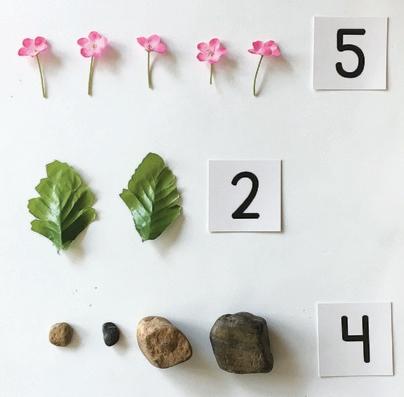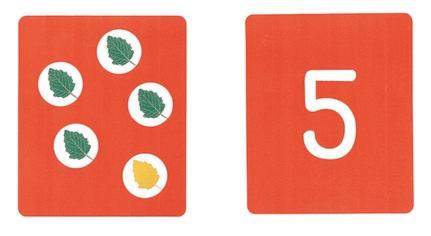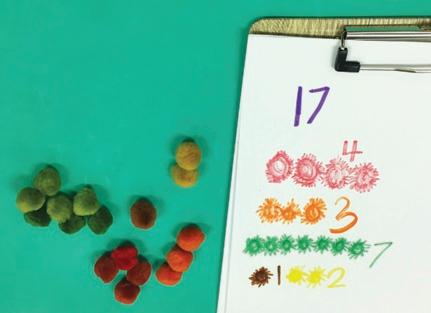
4 minute read
Counting and Cardinality
What is the number core? How is it tied to counting?
In this module, children have sustained interaction with four core ideas for describing the number of objects in a group. These ideas are collectively referred to as the number core.
• The number word list—Students say numbers in the appropriate count sequence (1, 2, 3, …).
• One-to-one correspondence—When counting, students pair one object with one number word, being careful not to count any objects twice or skip any objects.
• Cardinality—Students say a number to tell how many are in a group. They may be able to tell how many by subitizing, counting, or matching to group of known quantity. When counting, students recognize that the last number said represents the number of objects in the group.
• Written numerals—Students read and write the symbols used to represent numbers. They also connect the written numeral with the number of objects in a set.

Students must integrate all aspects of the number core to count and use numbers fluently. The majority of kindergarten activities should involve three or more elements of the number core in conjunction. The number core components are not learned in isolation.
The number core plays a foundational role in work with number relations, operations, and place value understanding and is thus a critical start to the kindergarten year.
Students use one-to-one correspondence when they say one number word for each spider they touch.
Students show how many are in a set (cardinality) using written numerals.
Why isn’t there a lesson for each number from 1 to 10?
Module 1 focuses on strategies rather than specific numbers. When students learn strategies for counting accurately, they are able to apply them to different numbers arranged in different configurations.
For instance, when counting in a circular configuration, the challenging part is identifying the starting and stopping points so that every object is counted once and only once. Once a student has learned a strategy for marking the start, that strategy can be useful in successfully counting any number of objects in a circular configuration. The same strategy for marking the start can also be used to count the sides and corners of shapes.
As early as possible, we want students to approach problem solving with a strategy that allows them to be accurate and efficient. When a lesson focuses on a single number, students go into the counting task anticipating the total. Counting tasks in which students do not already know the total but genuinely want to know the total open them to the process of choosing a strategy to solve a problem (MP1). With good questioning, students can begin to evaluate whether their chosen strategy is effective.
A focus on strategies rather than specific numbers means that the size of a set can be varied to challenge individual students. This approach creates accessibility and engagement for kindergartners with a range of counting experiences.


What is counting the math way? How does it affect later learning?
Fingers are familiar manipulatives that students have with them all day, every day, and if used intentionally, fingers can support conceptual understanding and problem solving throughout elementary school. Around the world, people use their fingers to represent numbers in many different ways. Depending on their cultural experiences, young children may begin counting on a thumb, pointer finger, pinkie, or even a section of a finger. Students learn to count the math way in module 1, starting with 1 on the left pinkie finger and continuing to 10 on the right pinkie finger.
The mathematical advantage of counting the math way is that students count from left to right without interruption, just as they do on the number path, and eventually, the number line. Students see and feel the quantity increase as they count forward. The steady increase in distance from the starting point is a physical and visual model for understanding the magnitude of a number.
Counting the math way has advantages for understanding number relationships that will be important in kindergarten and beyond.
• Unitizing. When students unitize, they make use of five as a whole instead of thinking of it as 5 individual pieces. The structure of our hands makes it easier for students to unitize 5 when they think about 6 as 5 and 1, 7 as 5 and 2, and so on. Unitizing is a key step to using Level 2 counting on strategies.
• Partners to 10. Fluency with partners to 10 is critical to Level 3 problem-solving strategies. When counting the math way, students can easily see that the raised fingers and the lowered fingers are partners to 10. Other ways of finger counting do not always keep the fingers representing each part next to one another.
• Embedded numbers. The ability to decompose a number into embedded parts is foundational to many Level 3 strategies. Showing parts within a total is easy when both parts are 5 or less. When modeling 2 + 3, a student can show one part on each hand. It is more challenging to see the parts when modeling 6 + 2. As fine motor skills develop, students can wiggle the fingers representing one part while holding the other part steady. Counting the math way creates consistency with how the embedded number looks inside the total.
This is a module about numbers to 10. Why do you suggest counting collections with as many as 25 objects?
Counting collections are rich tasks that allow students to explore numbers and engage with the mathematical practices. They are also authentic assessment opportunities for teachers.


The first counting collection, which occurs in lesson 6, is a diagnostic assessment as much as it is an opportunity to introduce counting strategies. Young children with regular access to high-quality math experiences may walk into kindergarten with the ability to organize, count, and represent sets of 50 or more objects. Providing larger counting collections gives those students a chance to share the full range of their abilities so teachers can differentiate instruction to meet their needs.
We suggest beginning with collections of between 5 and 25 objects for the following reasons:
• Research indicates that students may count farther when counting objects than they do when asked to rote count.1
• When students cross into the twenties, we see whether they can use the repeated pattern of number names in English (e.g., saying twenty-one instead of twenty-eleven).
• Young students are good at choosing a collection that matches up with their counting abilities when the collections have fewer than 25 objects. With larger collections, students can’t perceive the difference between collection sizes with enough accuracy to stay within a comfortable range.
• Experiencing success in early kindergarten activities is important to building students’ self-confidence and the sense that they are mathematicians.
The number of objects in a collection should increase in subsequent lessons (lessons 19 and 33) if any student shows mastery through 25. Try 40 or 50 objects and slowly increase the number until you find the spot where the student begins to need help with the number word list, or with organizing to maintain one-to-one correspondence.



